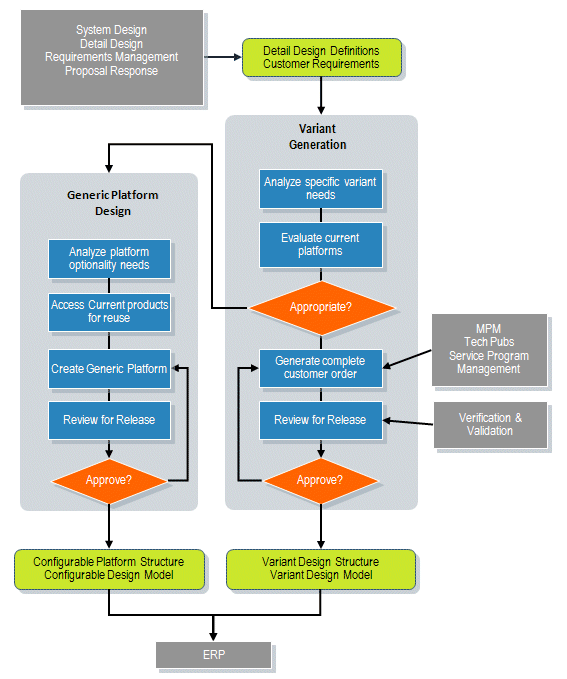Variant Design and Generation Process
Within the Product Development System process framework developed by PTC, the Variant Design and Generation process defines the steps that product development teams perform to implement the business strategies for supporting product families.
The typical Variant Design and Generation process has two major phases (see the next diagram):
• Generic Platform Design – Includes the steps to create and maintain a generic platform. A generic platform may be represented by an overloaded product structure that includes a variety of supported configurations for a product family or for a technology module.
• Specific Variant Generation – Includes the steps to create and update product variants.
Generic Platform Design
The following steps are typically performed during this phase:
1. Analyze platform optionality needs–Analyze the requirements of the new product and initially identify options to satisfy these requirements.
2. Assess Current Products for Reuse–Investigate existing variant designs for reuse and review new concepts.
3. Create Generic Product Definition–Develop the framework to support product optionality. Reuse existing parts, options, and rules. Define the new rules and logic needed to select the product options. Designs, rules, and product structure are evaluated and iterated, as necessary.
4. Release and Maintain Platform–After design and validation of the generic platform is completed, the generic platform is released to manufacturing planning or to manufacturing. Changes to the platform are managed in a controlled process.
Specific Variant Generation Phase
The following steps are typically performed during this phase:
1. Analyze Specific Variant Needs–Analyze market-specific or customer-specific needs.
2. Assess Current Platform for Reuse–Evaluate the existing generic platforms in order to select the one best suited for these needs.
3. Create Variant Definition–Define the configuration for the variant and generate initial deliverables such as part structures and other documentation. The specific variant design is edited and modified, as necessary.
4. Release and Maintain Variant–Once the specific variant is generated and approved, it is released to manufacturing. Changes to the variant are managed in a controlled process.

